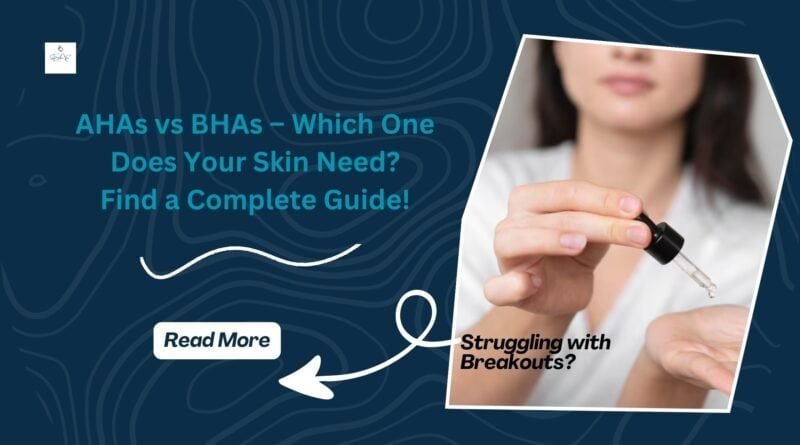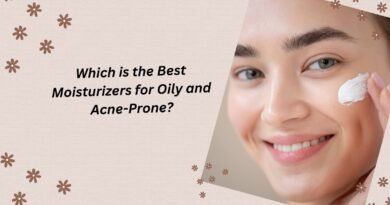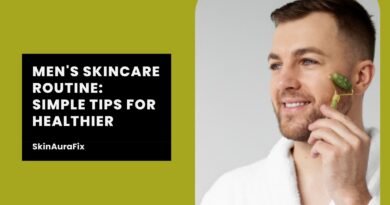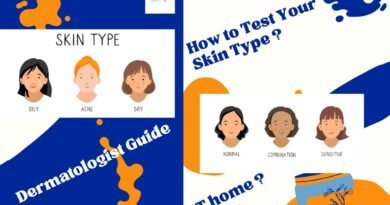AHAs vs BHAs: Clear Skin Guide for Every Skin Type
Ever picked up a skincare product and noticed “AHA” or “BHA” on the label, but didn’t really know what it meant? You’re not the only one. These ingredients are powerful exfoliants that can help with common skin concerns like dullness, acne, and uneven texture but only if you know how to use them right.
In this simple, beginner-friendly guide, we’ll explore what AHAs and BHAs actually are, how they work, who they’re best suited for, and how to use them without damaging your skin.
Whether you’re dealing with breakouts, rough patches, or just want that healthy glow, this breakdown will help you figure out if you should be using an AHA, a BHA, or even both. Let’s make skincare a little less confusing and a lot more effective.
AHA VS BHA: Overview of Exfoliating Acids
You know how your skin can look dull, dry, or just not that fresh? That’s because your skin naturally sheds dead cells, but sometimes they build up especially if you’re stressed, dehydrated, or skipping exfoliation.
This is where chemical exfoliants (like AHAs and BHAs) come in. Exfoliating acids play a vital role in modern skincare by promoting cell turnover, helping to remove dead skin cells, and revealing smoother, brighter skin underneath. This process improves skin texture, unclogs pores, and enhances the absorption of other skincare products.
The concept isn’t new historical figures like Cleopatra were said to bathe in sour milk, rich in lactic acid, to maintain soft, glowing skin. Today, exfoliating acids such as AHAs (like glycolic and lactic acid) and BHAs (like salicylic acid) are found in cleansers, toners, serums, and body care products. Wondering what acid is best for exfoliating? It depends on your skin type AHAs are great for dry or dull skin, while BHAs are ideal for oily and acne-prone types.
What Are AHAs?
AHAs, or alpha hydroxy acids, are water-soluble exfoliating acids commonly used in skincare. They come from natural sources such as sugarcane (glycolic acid), milk (lactic acid), and fruits (citric acid). AHAs work by gently removing dead skin cells from the surface, helping to improve skin texture and reveal a brighter, smoother complexion. They are also effective in reducing signs of aging like fine lines and uneven skin tone.
Common Types of AHAs:
| Type | What It Does | Who It’s For |
|---|---|---|
| Lactic Acid | Gentle + hydrating | Sensitive, dry skin |
| Glycolic Acid | Stronger, goes deeper | Dull, textured skin |
| Citric Acid | Brightening | Uneven tone |
| Mandelic Acid | Gentle exfoliator | Acne-prone, darker skin tones |
| Malic/Tartaric | Antioxidant-rich | Boosts other AHAs |
If your skin feels rough or looks dull, lactic or glycolic acid is a great place to start.
What Are BHAs? (Perfect for Pores & Acne)
BHAs, or beta hydroxy acids, are oil-soluble exfoliating acids used in skincare. Unlike AHAs, BHAs work both on the surface of the skin and deep inside the pores. This makes them especially helpful for people with oily, acne-prone, or bumpy skin. BHAs gently remove dead skin cells and clear out excess oil, helping to prevent breakouts and improve skin texture.
Main BHA: Salicylic Acid
The most common BHA is salicylic acid, which is naturally found in willow bark and wintergreen leaves. It is well-known for its ability to unclog pores, calm inflammation, and reduce blackheads and acne. Salicylic acid is often used in cleansers, toners, and spot treatments for clearer, smoother skin.
AHAs vs BHAs: Which One Should You Use?
Here’s a super simple comparison:
| Feature | AHAs | BHAs |
|---|---|---|
| Solubility | Water-based | Oil-based |
| Works on | Top of the skin | Inside pores |
| Best For | Dry, dull, aging skin | Oily, acne-prone, bumpy skin |
| Gentle? | Can be strong (start slow!) | Gentler for most |
| Skin Concerns | Texture, fine lines, pigmentation | Acne, blackheads, large pores |
Still confused? Here’s an example:
- Got flaky skin and fine lines? 👉 AHA
- Got breakouts and blackheads? 👉 BHA
- Got both? 👉 Use both, but alternate nights.
AHAs vs. BHAs: Key Differences
Alpha hydroxy acids (AHAs) are water-soluble and work mainly on the surface of the skin. They help remove dead skin cells, smooth rough texture, brighten dull skin, and reduce signs of aging like fine lines and dark spots. AHAs are ideal for people with dry, uneven, or sun-damaged skin. Common types include glycolic acid (from sugarcane), lactic acid (from milk), and citric acid (from fruits). While effective, AHAs especially glycolic acid can cause irritation in sensitive skin types due to their smaller molecule size, which allows deeper penetration.
Beta hydroxy acids (BHAs), such as salicylic acid, are oil-soluble, allowing them to go deeper into the pores. This makes them especially helpful for oily, acne-prone, or bumpy skin. BHAs unclog pores, reduce blackheads, calm inflammation, and help prevent breakouts. Salicylic acid, the most common BHA, is often derived from willow bark or wintergreen leaves. BHAs are generally gentler than AHAs and are a good choice for beginners or those with sensitive skin. If your main concerns are excess oil, acne, or clogged pores, BHAs are usually the better option. You can also watch a video for more details about BHA , AHA and PHA along with product guide.
What Are the Benefits of AHAs and BHAs?
Both AHAs and BHAs are effective exfoliants, but they offer different benefits depending on your skin’s needs. Here’s what each one can do:
Benefits of AHAs (Alpha Hydroxy Acids)
- Help brighten dull and uneven skin tone, giving a fresher appearance.
- Smooth rough or flaky texture by removing dead skin cells from the surface.
- Fade dark spots, acne marks, and sun damage over time.
- Gently reduce the appearance of fine lines and early signs of aging.
- Improve skin’s natural glow and promote a more even, radiant look.
- Support better hydration, especially with acids like lactic acid.
Benefits of BHAs (Beta Hydroxy Acids)
- Penetrate deep into pores to unclog buildup and reduce blackheads.
- Effectively treat and prevent acne by clearing excess oil and bacteria.
- Help minimize the appearance of large pores with consistent use.
- Reduce redness and calm inflamed or irritated skin.
- Control oily shine and help balance the skin’s natural oil levels.
- Improve overall skin clarity, especially for acne-prone or oily skin types.
Disadvantages and Side Effects of AHAs and BHAs
Although AHAs and BHAs are powerful ingredients in skincare, they can cause certain side effects, especially when used improperly or without proper aftercare. Below is a breakdown of their potential drawbacks.
AHAs: What to Watch Out For
1. Skin Irritation and Redness:
AHAs can sometimes cause a tingling or burning sensation, especially on sensitive skin. Overuse or high concentrations may lead to redness, flaking, or inflammation. It’s important to start with a lower concentration and monitor how your skin reacts.
2. Sun Sensitivity (Photosensitivity):
Using AHAs can make your skin more sensitive to UV rays, increasing the risk of sunburn. Daily sunscreen is a must when using products with glycolic, lactic, or citric acid—even if you’re mostly indoors.
3. Not Ideal for Broken or Very Sensitive Skin:
People with active skin conditions like eczema, rosacea, or open wounds should avoid AHAs unless advised by a dermatologist, as they can worsen irritation and disrupt the skin barrier.
BHAs: Possible Side Effects
1. Dryness and Peeling
BHAs like salicylic acid can cause dryness, especially when overused. This is because they penetrate deep into the pores and may remove too much oil, which can disrupt the skin’s natural moisture balance.
2. Not Recommended During Pregnancy
Salicylic acid, the main BHA, is often advised against during pregnancy due to concerns over absorption. Always consult with a healthcare provider before using BHA products if you are pregnant or breastfeeding.
3. Initial Breakouts (Purging Phase)
When first starting BHAs, some users experience a “purging” phase—where breakouts temporarily increase as clogged pores are cleared. While this is usually short-lived, it can be discouraging if you’re not expecting it.
How to Minimize Side Effects
- Start with lower concentrations and increase gradually.
- Always follow with a gentle moisturizer and sunscreen.
- Avoid combining too many active ingredients at once (like retinol and acids).
- Use products only as directed—overuse can do more harm than good.
How to Use AHAs and BHAs the Right Way (Without Damaging Your Skin)
Exfoliating acids are powerful but only when used correctly. Here’s a simple, safe routine to get the best results without irritating your skin.
Step-by-Step AHA/BHA Routine:
- Cleanse your face with a gentle, non-stripping cleanser.
- Apply your AHA or BHA product (toner, serum, or exfoliating peel) on dry skin.
- Wait 1–2 minutes to let the acid absorb properly.
- Moisturize to support the skin barrier this is essential after exfoliating.
- Apply SPF every morning. Acids increase sun sensitivity, even on cloudy days.
Use AHAs at night and BHAs in the morning, or alternate between them on different days to avoid over-exfoliation.
Who Should Use AHAs or BHAs?
Choosing the right exfoliant depends on your skin type and concern:
AHAs are best for you if:
- Your skin is dry, dull, or uneven in tone
- You want to fade pigmentation, fine lines, or texture
- Your skin tolerates active ingredients well
BHAs are ideal if:
- Your skin is oily, acne-prone, or has clogged pores
- You struggle with blackheads or inflammation
- You need something that works inside pores
Can we use both?
- You have combination skin
- You’re targeting both acne and dullness
- You alternate use and stick to gentle concentrations
Chemical vs. Physical Exfoliation: What’s the Difference?
| Type | How It Works | Best For |
|---|---|---|
| Chemical (AHAs/BHAs) | Dissolves dead skin cells | Sensitive, acne-prone, or aging skin |
| Physical (scrubs, brushes) | Manually removes dead skin cells | Occasional use, especially for body exfoliation |
You can combine both methods carefully. For example, use a physical scrub once a week, and chemical exfoliants 2–3 times per week—as long as your skin doesn’t feel dry or tight.
Final Thoughts: Should You Try AHAs or BHAs?
Yes if you want brighter, smoother, or clearer skin. Just remember to:
- Know your skin type and needs
- Start slow and don’t overdo it
- Always moisturize and use sunscreen
- Choose the right formulation (gentle acids for beginners)
Exfoliating acids can make a big difference—but only when used with care and consistency. If your skin feels dull, congested, or unbalanced, AHAs or BHAs could be exactly what you need to bring back your glow.
FAQS About AHAs & BHAs
Q: Can I use AHAs and BHAs together?
A: Yes, but only if the product is formulated for combined use. Otherwise, alternate them on different days to prevent irritation.
Q: How long does it take to see results?
A: Most people notice improvements in 4–6 weeks with regular, proper use.
Q: Is purging normal?
A: Yes, especially with BHAs. It’s a temporary phase as impurities come to the surface and should fade within a few weeks.
Q: Do I need sunscreen when using acids?
A: Absolutely. Daily sunscreen is non-negotiable when using any exfoliating acid.
Q: Can I use acids with retinol or vitamin C?
A: Not in the same routine unless guided by a dermatologist. These combinations can be too harsh and increase the risk of irritation.
So, hope so this article finds you fine and may you get a clear knowledge about these Exfoliating acids ( AHAs and BHAs ) . Seek medical assistance if you need.



